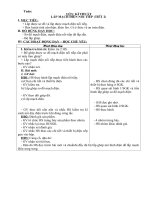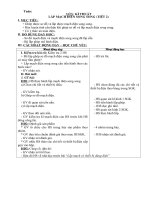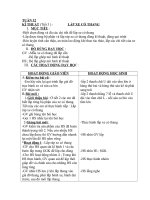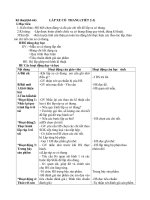GIAO ANH KI A 9
Bạn đang xem bản rút gọn của tài liệu. Xem và tải ngay bản đầy đủ của tài liệu tại đây (72.2 KB, 12 trang )
ENGLISH 9 LESSSON PLAN
Period: 1 UNIT 1: A LETTER FROM A PEN PAL
Week: 1
Ns: 03/9 Part 1&2: Getting started + Listen and read
Nd: 05/9
I. AIMS:
1. General knowledge:
After learning the lesson the sts can:
+ Make and respond to to instruction.
+ Scan for specific information.
+ Write a personal letter.
a. Vocabulary:
+ Connectives: and, but, because, or, so, therefore, however.
+ phrasal verbs: turn off/ on, look for, look after, go on.
b. Structures:
+ Make suggestions; suggest + V_ing/ suggest (that) + S + should
2. Skills: Develop the students' listening and reading skills.
3.Attitude: Help the students understand the need of saving energy in our everyday
life.
II. PREPARATIONS:
1.References: Teacher’s and students’ books.
2.Method: communicative approach.
3.Teaching aids : pictures, stereo, disk
III.TEACHING STEPS:
1.Classroom procedures:
- Greeting.
- Cheking attendance:
- 9A1:……………………………………………..
- 9A2:……………………………………………..
- 9A3:……………………………………………..
- 9A4:……………………………………………..
2.Review of the previous lesson: T. check the sts’ writing and doing of the homeworks
3.New lesson:
Stages Teacher’s and students’ activities Contents
Warm up T: ask the sts to tell about some of
the household applians their
families have.
Ex: electric lights, TV, stereo, fans,
……faucet.
Introduction
Comprehen
-sion check
Practice
Summary
Sts: answer the teacher.( as much
as possible)
T: we’re going to learn about how
to save energy in our family.
T asks the Sts to look at the picture
in part 1 and tell how people can
do to save the energy.
Sts: answer the questions
T: now listen and find out who are
talking in the conversation. Where
are they now?
Sts: listen and and answer the T’s
questions
T: explain some of the difficult
words and ask the sts to repeat the
words.
T: ask the sts to reproduce the
conversation.
Sts: reread the conversation
( silently) and do the True – false
exercise.
Sts: exchange their answers and
correct themselves.
T: give some questions on the
conversation.
Sts: reand and answer .
Sts: read the conversation aloud.
T: remind the sts of the new words
and structures learnt in the lesson.
Sts: give some examples
The pictures in 1 – pg: 57
- Is the TV on?
- Who’s watching TV ?
- Who’s litening to the radio?
- Is there anyone in the
bathroom?
The part 2: Listen and read. Pg: 57
Mrs. Mi and Mrs. Ha are talking over
the fence.
New words:
Enormous, reduce, amount of, faucet,
drip.
• suggest + V-ing
Questions:
1. Why is Mrs. Ha worried ?
2. How can she reduce the
amount of her family use ?
3. Should she take showers ?
• * suggest + V-ing
Ex: He suggests traveling by bus
instead of by motorbikes…..
• Experiences:
.....................................................................................................................................
* Homework:
- Learn the new words and read the lesson well.
- Prepare the next part of the Unit 7.
Period: 44 UNIT 7: SAVING ENERGY
Week: 22
Ns: 6/2 Part 3: SPEAK
Nd: 17/2
I. AIMS:
1.General knowledge:
After learning the lesson the sts can:
+ Show their concern and give respond to suggestions.
+ Discuss simply about how to save the energy.
a.Vocabulary:
+ Connectives: and, but, because, or, so, therefore, however.
+ phrasal verbs: turn off/ on, look for, look after, go on.
b.Structures:
+ Make suggestions; suggest + V_ing/ suggest (that) + S + should
2.Skills: Develop the students' speaking skill.
3.Attitude: Help the students understand the need of saving energy in our everyday
life.
II. PREPARATIONS:
1.References: Teacher’s and students’ books.
2.Method: communicative approach.
3.Teaching aids : pictures, word charts.
III. TEACHING STEPS:
1.Classroom procedures:
- Greeting.
- Cheking attendance:
- 9A1:……………………………………………..
- 9A2:……………………………………………..
- 9A3:……………………………………………..
- 9A4:……………………………………………..
2.Review of the previous lesson:
Some sts reproduce the conversation ( in pairs)
T: give marks and correct the sts’ mistakes.
3.New lesson:
Stages Teacher’s and students’ activities Contents
Warm up T: ask the sts to tell about some of
the household applians their
families have.
Sts: answer the teacher.( as much
as possible)
Ex: electric lights, TV, stereo, fans,
……faucet.
Pre-
speaking
While-
speaking
Post-
speaking
T: we’re going to speak about how
to save energy.
T asks the Sts to look at the picture
in part 3 and tell how people can
do to save the energy.
Sts: answer the questions
T: use word charts to introduce the
expressions of how to give and
answer suggestions.
Sts: listen and and repeat the
expressions
T: explain some of the difficult
words and ask the sts to repeat the
words.
T: ask the sts to work in group of 4
and has a secretary of each group
to write a plan to save energy for
the class.
Sts: discuss in groups and make
out the plans, using as much
expressions in 3a as posssible.
Sts: skeak out their plans and
other group correct or give
questions
T: summarize the good ideas of
each group to make an action plan
for the class.
T:remind the sts of the new words
and structures learnt in the lesson.
Sts: give some examples
The pictures in 3 – pg: 59
- What are people wasting in
picture A, B, C…..F?
- How can we save energy in G,
H ?
The part 3a:
Suggestion :
-I suggest + V-ing……
- I think we should…..
- Shall we……..?
- Why don’t we…….?
- How about + V-ing…..?
- What about + V-ing….?
- Let’s……
Respond:
- OK.
- That’s a good idea.
- No. I don’t want to……
- All right.
- I prefer to….
- Let’s……
• * suggest + V-ing
Ex: He suggests traveling by bus
instead of by motorbikes…..
• Experiences:
.....................................................................................................................................
.....................................................................................................................................
* Homework:
- Learn the new words and read the lesson well.
- Prepare the next part of the Unit 7.
Period: 45 UNIT 7: SAVING ENERGY
Week: 23
Ns: 16/2 Part 4: LISTEN
Nd: 22/2
I.AIMS:
1.General knowledge:
After learning the lesson the sts can:
+ Show their concern and give respond to suggestions.
+ Discuss simply about how to save the energy.
a.Vocabulary:
+ Connectives: and, but, because, or, so, therefore, however.
+ phrasal verbs: turn off/ on, look for, look after, go on.
b.Structures:
+ Make suggestions; suggest + V_ing/ suggest (that) + S + should
2.Skills: Develop the students' listening skill.
3.Attitude: Help the students understand the use of the new energy in our everyday
life – the energy from the sun.
II.PREPARATIONS:
1.References: Teacher’s and students’ books.
2.Method: communicative approach.
3.Teaching aids : word charts, stereo, disk.
III.TEACHING STEPS:
1.Classroom procedures:
- Greeting.
- Cheking attendance:
- 9A1:……………………………………………..
- 9A2:……………………………………………..
- 9A3:……………………………………………..
- 9A4:……………………………………………..
2.Review of the previous lesson:
Some sts give and respond to suggestions about how to save energy in our everyday
life ( in pairs)
T: give marks and correct the sts’ mistakes.
3.New lesson:
Stages Teacher’s and students’ activities Contents
Warm up T: ask the sts to tell about some of
th household applians their
families have.
Sts: answer the teacher.( as much
Ex: electric lights, TV, stereo, fans,
……faucet.









